The following is a list of game controllers . It includes input devices that are notable and whose primary function is to control how the video games are played. Regional variants and models containing insignificant changes are not included.
The following is a list of game controllers . It includes input devices that are notable and whose primary function is to control how the video games are played. Regional variants and models containing insignificant changes are not included.
| Name | Image | Platform | Specifications | Original release date | Refs |
|---|---|---|---|---|---|
| Magnavox Odyssey controller |  | Magnavox Odyssey | Connectivity: Magnavox Odyssey controller port Input: 3 knobs, 1 button | September 1972 | [1] |
| Shooting Gallery |  | Magnavox Odyssey | Connectivity: Magnavox Odyssey controller port Input: 1 trigger, photodiode | September 1972 | [2] |
| Atari CX40 joystick |  | Atari 2600 | Connectivity: Atari joystick port Input: 1 digital button, eight-directional digital joystick | 1978 | [3] |
| NES/Famicom controller |   | NES | Connectivity: NES controller port Input: 4 digital buttons, D-pad, microphone (Famicom only) | July 15, 1983 | [4] |
| NES Zapper |  | NES | Connectivity: NES controller port Input: 1 trigger, photodiode | February 18, 1984 | [5] |
| Master System controller |  | Master System | Connectivity: Master System controller port Input: 2 digital buttons, D-pad | September 1986 | [6] [7] |
| NES Advantage |  | NES | Connectivity: NES controller port Input: 4 digital buttons, 2 adjustable knobs, 3 toggle buttons, 1 switch | 1987 | [8] |
| Sega Genesis/Mega Drive controller |  | Sega Genesis | Connectivity: Sega Genesis controller port Input: 4 digital buttons, D-pad | October 29, 1988 | [9] [10] |
| Nintendo Power Glove |  | NES | Connectivity: NES controller port Input: D-pad, A, B, Start, Select, Turbo Buttons | December 3, 1989 | |
| SNES/Super Famicom controller |  | SNES | Connectivity: SNES controller port Input: 8 digital buttons, D-pad | November 21, 1990 | [11] |
| Gravis PC GamePad |  | DOS | Connectivity: DA-15 game port Input: 4 digital buttons, 2 switches, D-pad | 1992 | [12] |
| Menacer |  | Sega Genesis | Connectivity: Sega Genesis controller port Input: 4 buttons, 2 infrared transmitters | 1992 | [13] |
| Super Scope |  | SNES | Connectivity: 2nd SNES controller port Dimensions: 23 inches long Input: 3 digital buttons, 1 switch, photodiode | 1992 | [14] |
| 6-Button Arcade Pad |  | Sega Genesis | Connectivity: Sega Genesis controller port Input: 8 digital buttons, D-pad | 1993 | [9] [15] |
| Sega Saturn controller |  | Sega Saturn | Connectivity: Sega Saturn controller port Input: 9 digital buttons, D-pad | November 22, 1994 | |
| PlayStation controller |  | PlayStation | Connectivity: PlayStation controller port Input: 10 digital buttons, D-pad | December 3, 1994 | [16] |
| Virtual Boy controller |  | Virtual Boy | Connectivity: Virtual Boy controller port Input: 2 D-pads, 6 digital buttons, power switch | July 21, 1995 | [17] [18] |
| Apple Pippin controller |  | Apple Pippin | Connectivity: P-ADB Input: 9 digital buttons, D-pad, trackball | March 28, 1996 | [19] |
| Nintendo 64 controller |  | Nintendo 64 | Connectivity: Nintendo 64 controller port, Controller Pak slot Input: 1 analog stick, 10 digital buttons, D-pad | June 23, 1996 | [20] |
| SpaceOrb 360 |  | PC | Connectivity: Serial Input: 6-axis rubber ball, 6 buttons | 1996 | |
| ASCII Sphere 360 |  | PlayStation | Connectivity: PlayStation controller port Input: 6-axis rubber ball, 10 buttons, D-pad | ||
| 3D Pad |  | Sega Saturn | Connectivity: Sega Saturn controller port Input: 7 digital buttons, 1 analog stick, 2 analog triggers, 1 toggle switch, D-pad | July 5, 1996 | |
| Dual Analog Controller |  | PlayStation | Connectivity: PlayStation controller port Input: 10 digital buttons, 2 clickable analog sticks, 1 toggle button, D-pad | April 25, 1997 | [21] |
| DualShock |  | PlayStation | Connectivity: PlayStation controller port Input: 10 digital buttons, 2 clickable analog sticks, 1 toggle button, D-pad | November 20, 1997 | |
| Dreamcast controller |  | Dreamcast | Connectivity: Dreamcast controller port, 2 expansion sockets Input: 1 analog stick, 2 analog triggers, 5 digital buttons, D-pad | November 27, 1998 | [22] |
| DualShock 2 |  | PlayStation 2 | Connectivity: PlayStation controller port Input: 2 clickable analog sticks, 8 pressure-sensitive buttons, 2 digital buttons, 1 toggle button, pressure-sensitive D-pad | March 4, 2000 | |
| Nintendo GameCube controller | 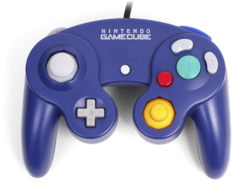 | GameCube | Connectivity: GameCube controller port Input: 2 analog sticks, 2 clickable analog triggers, 6 digital buttons, D-pad | September 14, 2001 | [23] |
| Xbox controller (aka The Duke) |  | Xbox | Connectivity: Xbox controller port, 2 Memory Unit slots Dimensions: 6.5 × 5 × 3 in Input: 2 analog triggers, 2 clickable analog sticks, 2 digital buttons, 6 pressure-sensitive buttons, D-pad Mass: <16 oz. | November 15, 2001 | [24] [25] |
| Xbox Controller S |  | Xbox | Connectivity: Xbox controller port, 2 Memory Unit slots Input: 2 analog triggers, 2 clickable analog sticks (offset), 2 digital buttons, 6 pressure-sensitive buttons, D-pad | 2002 | |
| Xbox 360 controller |  | Xbox 360 | Connectivity: USB, wireless (proprietary 2.4 GHz protocol), 2.5 mm headset jack Input: 2 analog triggers, 2 clickable analog sticks (offset), 10 digital buttons, D-pad | November 22, 2005 | [26] |
| Sixaxis |  | PlayStation 3 | Connectivity: Bluetooth, USB Input: 2 clickable analog sticks, 2 analog triggers, 6 pressure-sensitive buttons, 3 digital buttons, pressure-sensitive D-pad, accelerometer, gyroscope | November 11, 2006 | [27] |
| Wii Remote |  | Wii | Connectivity: Bluetooth, Accessory connector port (400 kHz I²C) Input: 8 digital buttons, accelerometer, D-pad, gyroscope (Wii Remote Plus only), infrared sensor | November 19, 2006 | [28] |
| Nunchuk |  | Wii | Connectivity: Accessory connector plug (400 kHz I²C) Input: 1 analog stick, 2 digital buttons, accelerometer, | November 19, 2006 | [29] |
| Classic Controller | 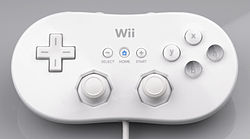 | Wii | Connectivity: Accessory connector plug (400 kHz I²C) Input: 2 analog sticks, 2 clickable analog triggers, 9 digital buttons, D-pad | November 19, 2006 | |
| DualShock 3 |  | PlayStation 3 | Connectivity: Bluetooth, USB Input: 2 clickable analog sticks, 2 analog triggers, 6 pressure-sensitive buttons, 3 digital buttons, pressure-sensitive D-pad, accelerometer, gyroscope | November 11, 2007 | [27] |
| Classic Controller Pro |  | Wii | Connectivity: Accessory connector plug (400 kHz I²C) Input: 2 analog sticks, 11 digital buttons, D-pad | Early 2009 | |
| PlayStation Move |  | PlayStation 3, PlayStation 4 | Connectivity: Bluetooth, mini-USB port Input: 1 analog trigger, 8 digital buttons, accelerometer, gyroscope, magnetometer | September 15, 2010 | [30] |
| PlayStation Move Navigation controller |  | PlayStation 3 | Connectivity: Mini-USB port Input: 1 analog trigger, 1 clickable analog stick, 4 digital buttons, D-pad | September 15, 2010 | [30] |
| Kinect for Xbox 360 |  | Xbox 360 | Connectivity: USB 2.0 Dimensions: 282 × 68 × 70 mm Input: 1 RGB camera, 2 infrared depth sensors, four-microphone array Mass: 1360 g | November 4, 2010 | [31] |
| Wii U GamePad | 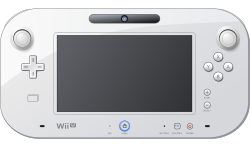 | Wii U | Connectivity: Proprietary wireless, Accessory Connector port, AC adapter port, headset jack, near-field communication Input: 13 digital buttons, 2 clickable analog sticks, touchscreen, D-pad, accelerometer, front-facing camera, infrared transceiver, gyroscope, magnetometer, microphone, slider | November 18, 2012 | [32] [33] |
| Wii U Pro Controller | 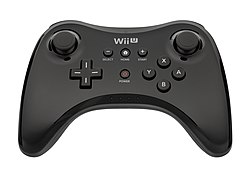 | Wii U | Connectivity: Bluetooth Input: 2 clickable analog sticks, 13 digital buttons, D-pad | November 18, 2012 | |
| Ouya Controller |  | Ouya | Connectivity: Bluetooth Dimensions: 163 x 109 x 53.5 mm Input: 2 clickable analog sticks (offset), 2 analog triggers (LT, RT), 2 shoulder buttons (LB, RB), 5 digital buttons (O, U, Y, A, Menu), Touchpad, and Digital D-Pad Mass: 275 g | June 25, 2013 | [34] |
| DualShock 4 |  | PlayStation 4 | Connectivity: Bluetooth, Micro-USB, 3.5 mm stereo headset jack, extension port Dimensions: 161 × 57 × 100 mm Input: 9 digital buttons, 2 analog triggers, 2 clickable analog sticks, accelerometer, D-pad, gyroscope, two-point capacitive clickable touchpad Mass: 210 g | November 15, 2013 | [35] [36] |
| Xbox Wireless Controller |  | Xbox One, Xbox Series X/S | Connectivity: Propriety Wireless, Micro USB (revisions prior to Elite Series 2), USB-C (Elite Series 2 and third revision), 3.5 mm stereo audio jack (after first revision), Bluetooth 4.0 (second revision), Bluetooth LE (third revision) Dimensions: 153 × 102 × 61 mm Input: 2 clickable analog sticks (offset), 2 analog triggers (LT, RT), 2 shoulder buttons (LB, RB), 9 digital buttons (Y, B, A, X, Menu, Options, Home), 1 Share button (third revision) and Digital D-Pad | November 22, 2013 | |
| Kinect for Xbox One |  | Xbox One | Connectivity: USB 3.0 Dimensions: 249 × 66 × 67 mm Input: 1 RGB camera, 1 infrared depth sensor, four-microphone array Mass: 1.4 kg | November 22, 2013 | [31] |
| Steam Controller |  | Linux, Mac OS, Windows | Connectivity: Micro-USB, wireless Input: 2 clickable analog triggers, clickable analog stick, 2 clickable touchpads, 9 digital buttons, accelerometer, gyroscope | November 10, 2015 | [37] [38] [39] |
| Joy-Con |  | Nintendo Switch | Connectivity: Bluetooth; R: near-field communication Dimensions: 102 × 35.9 × 28.4 mm Input: Accelerometer, gyroscope; L: 10 digital buttons, clickable analog stick; R: 10 digital buttons, clickable analog stick, infrared motion camera Mass:L: ≈ 49.3 g; R: ≈ 52.2 g | March 3, 2017 | [40] |
| Nintendo Switch Pro Controller | 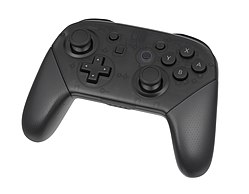 | Nintendo Switch | Connectivity: USB-C, Bluetooth, near-field communication Input: Accelerometer, gyroscope; 13 digital buttons, 2 clickable analog sticks | March 3, 2017 | |
| Google Stadia Controller |  | Google Stadia | Connectivity: Wi-Fi, USB-C, Bluetooth Low Energy 4.2 (BLE), 3.5mm stereo headset jack Dimensions: 163 x 105 x 65 mm Input: 2 clickable analog sticks, 2 analog triggers (L2, R2), 2 shoulder buttons (L1, R1), 9 digital buttons (Y, B, A, X, Menu, Options, Capture, Google Assistant, Stadia), and Digital D-Pad Mass: 268 g | November 19, 2019 | [41] [42] |
| Sinden Light Gun | Windows, Linux | Connectivity: USB-A Input: D-pad, 4 buttons | September 2020 | [43] | |
| DualSense |  | PlayStation 5 | Connectivity: USB-C, Bluetooth 5.1, 3.5mm TRRS (OMTP) stereo headset jack Dimensions: 160 × 66 × 106 mm Input: 6 axis motion sensing (3 axis accelerometer, 3 axis gyroscope), 2 clickable analog sticks, 2 analog triggers, 9 digital buttons, D-pad, 2 point capacitive touchpad with click mechanism (see buttons) Mass: 280 g | November 12, 2020 | |
| Amazon Luna Controller | Amazon Luna | Connectivity: Wi-Fi, USB-C, Bluetooth Low Energy 4.2 (BLE), 3.5mm stereo headset Dimensions: 156.4 x 107.6 x 58.5 mm Input: 2 clickable analog sticks (offset), 2 analog triggers (L2, R2), 2 shoulder buttons (LB, RB), 8 digital buttons (X, Y, A, B, Home, Action, Menu, Microphone), and Digital D-Pad Mass: 281.5 g | March 1, 2022 | [44] [45] [46] | |
| Joy-Con 2 |  | Nintendo Switch 2 | Connectivity: Bluetooth; R: near-field communication Dimensions: 102 × 35.9 × 28.4 mm Input: Accelerometer, gyroscope; L: 10 digital buttons, clickable analog stick, optical mouse sensor; R: 10 digital buttons, clickable analog stick, optical mouse sensor Mass:L: ≈ 66 g; R: ≈ 67 g | June 5, 2025 | |
| Nintendo Switch 2 Pro Controller | Nintendo Switch 2 | Connectivity: USB-C, Bluetooth, near-field communication Input: Accelerometer, gyroscope; 13 digital buttons, 2 clickable analog sticks | June 5, 2025 |
The following is a list of gaming mice , mice which are designed specifically to play games:
| Name | Image | Platform | Specifications | Original release date | Refs |
|---|---|---|---|---|---|
| Super NES Mouse | 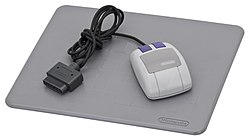 | SNES | Connectivity: SNES controller port Input: 2 buttons | July 14, 1992 | [47] |
| PlayStation Mouse |  | PlayStation | Connectivity: PlayStation controller port Input: 2 buttons | December 3, 1994 | [48] [49] |
{{cite book}}: |work= ignored (help)